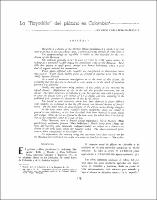| dc.description.abstract | Rayadilla is a disease of the plantain (Musa paradisiaca L) which is of cour mon occurrence in the Cauca Rives valley, Colombia (average altitude of 1.000 meters).
The symptomatology of "rayadilla is similar to that described for the thus disease of the Musaceae.
The outbreak generally occms in areas of 1.000 to 1500 square meters, at-tacking in a somewhat variable degree the commercial crops of this Musaceae Raza dilla also appears in small groves situated near buman babitations, where a great deal of organic material has accumulated.
When plants afflicted with rayadilla are transplanted to disease-free zones, they recover When sound, healthy plants are planted in affected areas, some 80 to 100% become diseased
As a result of numerous investigations as to the cause of this disease, the possibility that this was due to bacterial or vinus action or to the attack of nematode parasites was discarded.
Finally, leaf applications using solutions of zinc sulfate at 2% conected the typical clovosis Applications of zinc to the soil also provided correction, but not always The latter occurrence is explained by the fact that the soils with a propensity to cause the disease have a pH content of 82 or higher and this, according to the published facts, prevents the absorption of zinc by the plants.
The partial or total recoveries, which bave been observed in plants afflicted with vayadilla, are explained in that the pH content was lowered because of precipi-tation. On the other hand, an intensification of the disease occurs during droughts In the same zones where rayadilla occurs, symptoms, which are related in geneval to zinc deficiency, as bas been described, have been observed in cacao, coffee and oranges. Other species are affected in the same areas, for which there is no descrip-tion of the symptoms caused by a lack of zinc Other Musaceae, such as banana (Musa sapientum), liberal plantain (Musa paradisiaca), resplandor plantain (Musa balbisiana), Manila hemp plant (Musa tex-tilis) and traveling palm (Ravenala madagascariensis) are subject to a characteristic disease in the same zones where the rayadilla occurs The above-mentioned plants recover when transplanted to disease-free soil No experiments for recovery using zinc reæment bave been carried out for the Musaceae last mentioned, nov in the non-musaceae found in the area. | es_ES |


